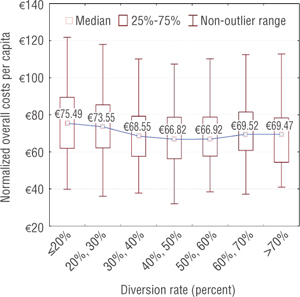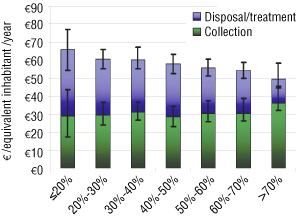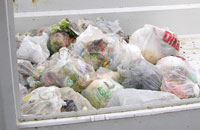 BioCycle April 2010, Vol. 51, No. 4, p. 52
BioCycle April 2010, Vol. 51, No. 4, p. 52
The Italian model of intensive residential food waste collection achieves impressive diversion rates without higher costs, and is catching on in Spain and the United Kingdom.
Michele Giavini and Christian Garaffa
Intensive source separation of organics (ISSO) represents a strategic decision, and is Italy’s key factor for reaching an overall high performance of residential source separation schemes. It has the dual purpose of maximizing organics diversion from landfills and reducing the amount of putrescible materials in residual waste to less than 10 percent. This allows residual waste collection frequency to be drastically reduced, making the overall scheme economically viable.
ISSO started in the northern part of Italy in the mid-1990s, with two driving forces: lack of space in landfills and (consequently) increasing tipping fees. Compared to the traditional scheme still in use in many parts of Italy, which is based on large centralized containers placed on the roads (“bring” schemes), ISSO is a “fetch” scheme and has some distinctive features that boost the quality and diversion rate of recyclable fractions. All of the waste fractions (organics, dry recyclables and residual waste) are collected at the curbside.
Several characteristics of ISSO make it highly successful. Food waste is set out in small, certified compostable bags while curbside collection of yard trimmings is discouraged to address waste minimization. Yard trimmings collection is limited to seasonal services linked to PAYT (pay as you throw) systems, and via promotion of backyard composting when possible (the general rule is: “when there is a courtyard that produces green waste there is also an area to do home composting”). In any collection scheme (bring or fetch), citizens have the option of taking materials such as yard trimmings to drop-off locations (recycling facilities or waste transfer stations).
A major benefit of ISSO is an overall decrease in residential waste generation, due to limits on curbside setouts. Nonresidential waste is also reduced because it can no longer be dropped off anonymously in centralized roadside containers. The integration approach calls for high frequency collections of food waste, in order to keep organics low in the residual waste stream. Organics collection typically ranges from two to three times a week, depending on the Mediterranean/Continental climate and season. This enables use of smaller (4 to 6 cy capacity) collection trucks without compaction. Single family homes are given 8- or 10-gallon curbside bins, which can be manually tipped, reducing collection time; condos are provided 32- to 64-gallon carts (mechanically tipped), serving 10 to 20 households each. Two-gallon vented kitchen pails and yearly supplies of compostable bags are given to each household (bags are certified according to European compostability standard EN 13432). Residual waste typically is collected weekly.
Positive Economics
After 15 years of experience in the field, estimates from 2009 show that more than 1,800 municipalities in Italy are source separating according to the ISSO model. Additionally, another 700 are using the “bring” scheme with centralized carts (100 to 250 gallons) for organics collection, placed on the roads and serving many households at the same time. The differences in capture rates and purity of the collected materials are striking: Participation rates are 80 percent or greater and impurities are less than four percent in most situations.
A key aspect of ISSO is its economic viability. A survey completed in March 2010 focused on the economics of collection schemes in the Region of Lombardy, in northern Italy. Milan is the capital of Lombardy, and the region contains one-sixth of Italy’s population. The survey was based on detailed economic data reported by all 1,546 municipalities in the region (including Milan), which shows that door-to-door collections with the ISSO model are highly effective when looking at overall costs.
All municipalities in Lombardy are required to enter detailed data about waste collection in a web-based application approved by the Regional Environmental Agency (ARPA). According to this database, about 850 municipalities in the region are collecting with the ISSO model, about 300 municipalities collect food waste using centralized road containers and the remaining communities do not collect food waste at all. An economic evaluation of the data finds that average overall costs (including collection, disposal and recycling) for municipalities with the ISSO model are approximately 10 percent lower than the other sample (road containers), but with almost twice the diversion rate (averaging 53.2 percent compared to 30.5 percent). Among the municipalities following the ISSO model, 192 show a diversion rate of 60 percent or greater, yet bear the same average costs as those diverting less than 40 percent.
 Some unexpected outcomes were uncovered by the survey, based on use of a new indicator for evaluating economic efficiency. This indicator expresses normalized overall costs for waste collection and treatment per equivalent inhabitant, per year (i.e. accounting for nonresident citizens and nondomestic activities), and excludes costs not directly related to waste collection such as road cleaning (Figure 1). One of these outcomes is lack of a strong relationship between overall costs and geographic or demographic parameters, meaning that waste management costs don’t change much between densely and sparsely populated areas. This is because every municipality succeeded in fitting the general collection model to its specific circumstances.
Some unexpected outcomes were uncovered by the survey, based on use of a new indicator for evaluating economic efficiency. This indicator expresses normalized overall costs for waste collection and treatment per equivalent inhabitant, per year (i.e. accounting for nonresident citizens and nondomestic activities), and excludes costs not directly related to waste collection such as road cleaning (Figure 1). One of these outcomes is lack of a strong relationship between overall costs and geographic or demographic parameters, meaning that waste management costs don’t change much between densely and sparsely populated areas. This is because every municipality succeeded in fitting the general collection model to its specific circumstances.
 Another impressive outcome, shown in Figure 2, illustrates the different costs for collection and treatment/disposal, using subsets of municipalities with the same recyclables diversion rate. It is clear that overall treatment costs decrease with higher diversion rates, because of the lower tipping fees for most recyclables. Collection costs tend to slightly increase (especially with over 60 percent diversion), but not as much as was commonly thought before this study. This is the result of collection frequency optimization performed by municipalities after years of experience with the first pilot areas.
Another impressive outcome, shown in Figure 2, illustrates the different costs for collection and treatment/disposal, using subsets of municipalities with the same recyclables diversion rate. It is clear that overall treatment costs decrease with higher diversion rates, because of the lower tipping fees for most recyclables. Collection costs tend to slightly increase (especially with over 60 percent diversion), but not as much as was commonly thought before this study. This is the result of collection frequency optimization performed by municipalities after years of experience with the first pilot areas.
Education Is Key
Education campaigns are crucial for the success of ISSO collection, as citizens must believe in what they are pushed or required to do. These campaigns also need to be repeated, perhaps every other year. For instance, ETRA SpA, an Italian company, manages the integrated water and municipal solid waste treatment service in the Veneto Region. A recent study by ETRA of 170 municipalities doing ISSO found that when there is a “not monitored” situation (i.e. without sensitization/education campaigns), impurities in food waste increase to seven to eight percent, compared to the standard of two to three percent in a well-managed situation. For reference, when residential organics are collected with big road containers, impurities can get up to 10 to 20 percent. ETRA started a communication campaign called “umido pulito” (“clean food waste”) which helped in reducing contamination back to the 2 to 3 percent level, resulting in savings of about 1 €/inhabitant/year. The contamination level is particularly important because it leads to extra costs at organic recovery facilities.
Another very important issue is what method is used to deliver compostable bags to citizens for the collection of organics. Where they are provided for “free” (the cost is charged on the waste tax fees), the collection works perfectly. Another option is free (but controlled) distribution of bags through a local retail network, or via prepaid cards used at vending machines that sell bags (charged directly to the waste tax). Collection quality and participation decreases when citizens are not directly supplied with compostable bags. Although some will purchase the bags at retail stores, others will tend to use noncompostable bags or won’t participate in the SSO scheme at all.
The remaining challenge to address is when municipalities still allow food waste collection in polyethylene bags, thinking only of the short-term costs being cheaper than biodegradable/compostable bags. This initial price doesn’t factor in higher overall costs due to more intensive and expensive pretreatment and screening systems to handle plastic contamination at organic recovery facilities, disposal of plastic residues, and risks of producing a lower quality compost.
Another important strategy with ISSO – to ensure high diversion rates while controlling overall cost – is to optimize collection frequencies. This must be done when the municipality first starts the new curbside collection scheme. Occasionally local governments are afraid that citizens will reject a lower frequency collection scheme and try setting an experimental transition period to ease into the new program. However, this endangers the viability of the whole program, because it’s very difficult to then implement a stricter program once citizens get used to an “easy” model. Instead, the desired collection frequency should be implemented from the beginning, using the aforementioned household tools to ease the transition: two bins (kitchen and curbside), as well as a supply of compostable bags.

Overall, ISSO schemes in northern Italy have been widely successful, and continue to influence trends in other countries. The model is spreading to European countries such as Spain and the United Kingdom, particularly in areas where some concurrent elements are present: lack of landfill space and increasing tipping fees, available or planned composting or anaerobic digestion capacity, regional regulations mandating separate organics collection and adoption of the diversion targets given by the European Union Landfill Directive 99/31/EC.
Michele Giavini runs Ars Ambiente Srl, a consultancy for waste management focusing on source separation and planning of composting facilities. (giavini@arsambiente.it). Christian Garaffa is Marketing Manager for source separation & recycling at Novamont SpA, producers of compostable polymers. He chairs the working group for waste & recovery of the European Bioplastics Association (christian.garaffa@novamont.com).
Michele Giavini and Christian Garaffa will be presenting on this topic in greater detail at the 7th annual ORBIT Conference (June 29 to July 3, 2010), held in Crete, Greece. For more information on the event, visit www.orbit2010.gr.
April 22, 2010 | General










